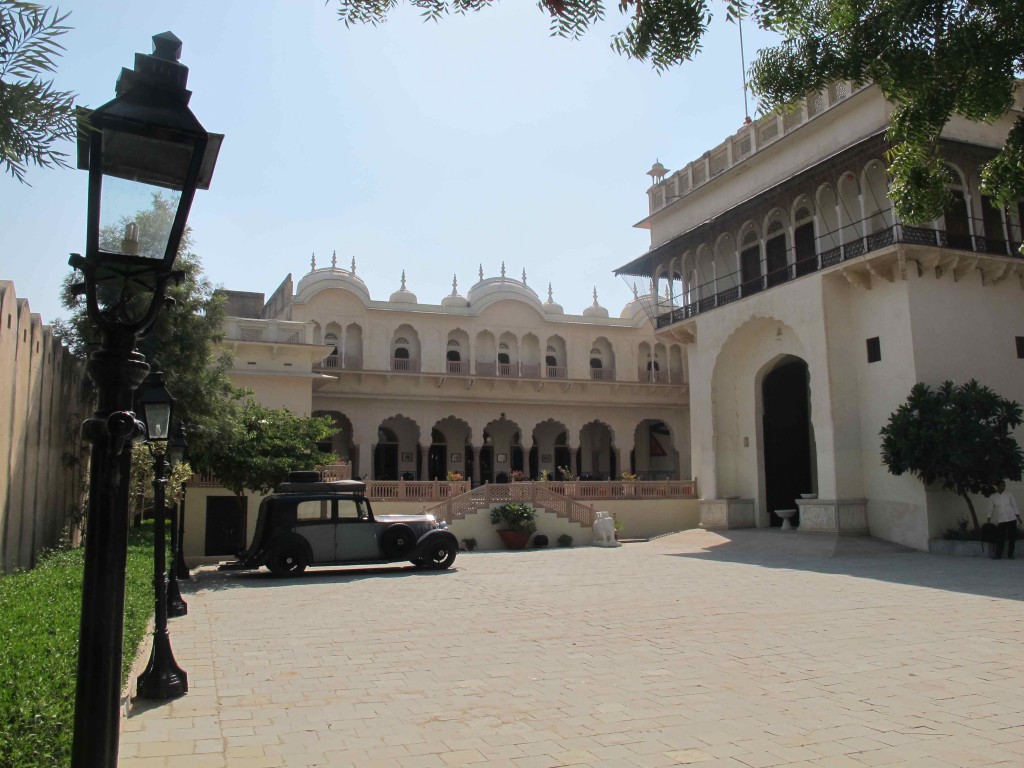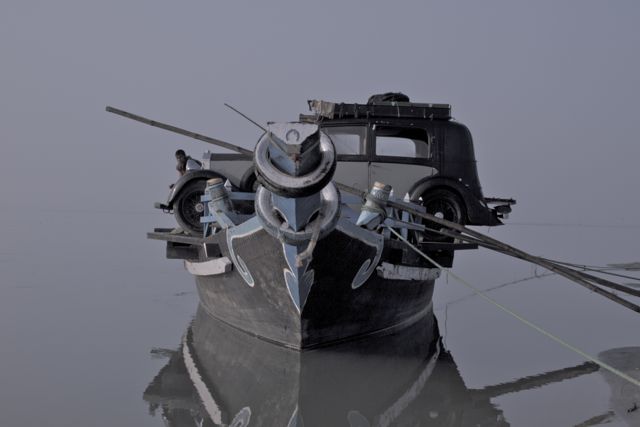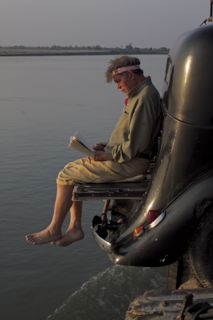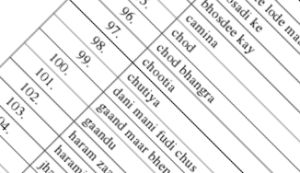
Following on from Tom Hatlestad?s epic journey from Oslo to Dhaka in a Land Rover, Rupert Grey and the Grey family, roll into town in a Rolls. It?s not just any old Rolls Royce. Rupert, a lawyer with a passion for photography, is the great grandson of the former British? prime minister Earl Grey (whom the tea is named after), whose statue adorned Westminster Abbey. A regular visitor to Chobi Mela, Rupert decided to bring his 1936 Rolls Royce to Dhaka for the festival. The antique Rolls had travelled through the Rajasthan deserts and gone along the foothills of the Himalayas and followed the Brahmaputra to Bangladesh, but was stopped at the Tamabil border, when bureaucracy kicked in.

The traditional method of temporary entry for cars, the carnet, had been stopped in Bangladesh and there was no law that would allow the car to make it?s final let. But as Rupert himself quotes, ?Bangladesh is also a country where everything is possible? ?and after a very long and protracted process where all the right people had to be convinced of the genuineness of the venture, and with much help from many different quarters, the car finally made it?s way into Bangladesh. Only to be stopped enroute to Dhaka because of a petrol strike.

The car arrives in Dhaka today and will be joining the traditional Chobi Mela rally in front of the National Museum tomorrow (the 25th January) at 3:00 pm. It is here at Chobi Mela where the rickshaw meets the Rolls.
—–
Arshad Jamal, Khushi Kabir, Gitiara Chowdhury, Kamran Chowdhury and especially Saleh Ahmed all worked behind the scenes to make this happen. In the end though it was the Chairman of NBR who found the way to get through the legal hoops.
Category: Humour
Forging Airline Tickets for Fun and Public Service
Dispatches from India – part 3
By Anu Garg
After a week in India attending a wedding, I was ready to head home to Seattle. As I approached the entrance to the Indira Gandhi International Airport, New Delhi, I had my passport and my travel cheat-sheet out. I knew you need a passport and a copy of your itinerary even to enter an airport in India. The security guard at the entrance inquired, “Passport and ticket?”
I handed him my passport and cheat-sheet on which I cram all my travel information (itinerary, frequent flier numbers, phone numbers, addresses, and other travel information), all on a single sheet. I may have to reduce margins, but I make sure that everything fits on no more than one sheet of paper.
The security man ignored the passport and pored through the flight info on the sheet and asked, “Where’s the passenger name on the ticket?” I told him that it had the flight info, but no need to add my name to the sheet as I already knew my name.
“Sir, I can’t let you in without your name on this.”
“But I have traveled in the past without any problem.”
“Sir, we have to follow the rules.” Apparently security had been tightened. Continue reading “Forging Airline Tickets for Fun and Public Service”
Shake up your story
Artist Raghava KK demos his new children’s book for iPad with a fun feature: when you shake it, the story — and your perspective — changes. In this charming short talk, he invites all of us to shake up our perspective a little bit.
Please retweet #children #art #ipad
Related articles
Artist Raghava KK demos his new children’s book for iPad with a fun feature: when you shake it, the story — and your perspective — changes. In this charming short talk, he invites all of us to shake up our perspective a little bit.
War for the Whitehouse
Scary, despite the mirth.
Sense of humour failure
Subscribe to ShahidulNews
Censorship in Pakistan
Economist
Nov 25th 2011, 13:04 by L.M.
AN OFTEN overlooked perk of being a country with a large population and relatively low wages is the capacity to employ people to carry out silly tasks. In India, for example, some people spend their days pasting white stickers onto maps of Kashmir printed in foreign publications (such as?The Economist). In neighbouring Pakistan, the regulatory body for telecommunications dreamed up an equally unlikely, if altogether more entertaining, assignment for its staff: to compile a list of ?undesired words? that could be used to block offensive text messages. In a remarkable show of efficiency (to say nothing of creativity), the agency managed to find?1,100 words and phrases in English and nearly?600 in Urdu. (Admittedly they may have padded it out a bit?how else to explain the presence of ?robber?, ?oui? or ?k mart? in a list that otherwise places rather more emphasis on sexual adventurism?)
Last week, the Pakistan Telecommunication Authority?s (PTA) memo and accompanying list of the words sent to mobile-phone service providers were leaked on the internet. Pakistanis were aghast and amused in equal measure. Previous bans have?targeted Facebook,?Rolling Stone magazine?s website and the use of encrypted networks. These met with limited opposition. But the directive to block text messages containing certain words was seen as an attack on free speech.
The official reason for the ban was ?to control the menace of spam in the society?. Far more likely, the authorities finally grew tired of rude anti-government jokes that circulate widely via text message. Many feature the president, Asif Ali Zardari, in a starring role. (A tame example: ?The post office issued new stamps with Zardari?s face on them but they had to be withdrawn because the public found them too confusing: it was impossible to tell which side to spit on.?) Texting is perhaps the most effective means of mass communication in Pakistan: two of every three Pakistanis have a mobile phone and the cost of sending an SMS is among the cheapest in the world. Following public uproar, damning editorials and the threat of legal action from NGOs, the authority sheepishly announced that ?implementation of previous PTA instructions have been withheld? after it ?received input from customers, government and other quarters on this issue?.
The government?s inability to take a joke isn?t restricted to text messages. In an interview with the state broadcaster on November 21st, the UN?s ?world television day?, the information minister, Firdous Ashiq Awan, stressed the need for a code of conduct to help broadcast media through an ?evolutionary phase?. There is little doubt that Pakistan?s news channels could do with some restraint, especially when it comes to coverage of terrorist attacks, which tends towards the gory. But critics fear that an enforced code of conduct would use obscenity as an excuse to target the hugely popular political satire programmes that make fun of the nation?s ruling classes. ?It?s anti-government stuff, impersonations of Zardari and company?they don?t leave anyone alone. They make all kinds of jokes, some of them quite lewd,? said Murtaza Razvi, a senior editor at?Dawn, a leading English-language newspaper.
Pakistan?s broadcasting rules were liberalised under Pervez Musharraf soon after he took power in a military coup in 1999, and the number of television channels quickly grew from a single state broadcaster to nearly a hundred channels. The government would do well to draw a lesson from the experience of Mr Musharraf, who tried to clamp down on press freedom in 2007 and found himself out of office soon after. Mr Zardari may not enjoy being the butt of jokes every night but it certainly beats having angry?protesters on the streets of Islamabad.
The foibles of the world
Subscribe to ShahidulNews
Martin Parr reveals the secret of taking photographs that tell the unvarnished truth
By Benjamin Secher
27 Aug 2011
‘Most of the photographs in your paper, unless they are hard news, are lies,? says Martin Parr. ?Fashion pictures show people looking glamorous. Travel pictures show a place looking at its best, nothing to do with the reality. In the cookery pages, the food always looks amazing, right? Most of the pictures we consume are propaganda.?
Parr, 59 years old and perhaps Britain?s best known photographic chronicler of modern life, is sitting in the kitchen of his beautiful Georgian house in Clifton, Bristol. He has served me tea from a fine china pot and ?posh biscuits? bought from the deli up the hill. Susie, his wife of 30 years, is stirring something on the hob. Everything looks rather lovely.
Everything, that is, except the appalled expression on Parr?s face when I suggest that sometimes, regardless of their truthfulness, pictures of things looking their best might be exactly what people want to see. ?Of course,? he says, ?but what people want?? He hits that last word with the force of a punch, then lapses into silence, as if the very thought of taking a photograph that perpetuates a fantasy disgusts him beyond words.
?If you go to the supermarket and buy a package of food and look at the photo on the front, the food never looks like that inside, does it? That is a fundamental lie we are sold every day. Part of the role of photography is to exaggerate, and that is an aspect that I have to puncture. I do that by showing the world as I really find it.?
A new exhibition, Martin Parr: Bristol and West, opening in the city next week, reminds us quite what a ridiculous, contradictory, dysfunctional and occasionally wonderful place Parr finds the world to be. Focusing on the part of the world that he has called home for the past 25 years, its 60 images, both old and new, suggest that whatever else has changed about photography over the intervening decades ? the advent of digital cameras, the death of film ? Parr?s gaze remains as acute and unsentimental as ever.
Has anybody ever looked their best in a Martin Parr photograph? Certainly not the mustachioed yacht salesman shot at Bristol regatta in 1989, his face, as he courts a couple of would-be buyers, frozen in a rictus of obsequiousness. Nor the group of girls Parr stumbled upon at Badminton horse trials, as much a product of good breeding and aggressive grooming as the fillies they have gathered to watch.
That picture finds its echo in another shot in the show, taken 20 years later, of a different quartet of girls of a similar age ? smoking, teetering on a lamplit pavement on a night out in 2009, off-guard, half-cut, mouths open, eyes closed. Parr?s images frequently raise a smile by exposing the gap between the public faces we wear and the private motives and insecurities that, if you know when and where to point a camera, can be seen seeping out from beneath. But if there is a joke here, nobody has let his subjects in on it.
When he is taking a photograph, Parr says, his prime responsibility isn?t towards the people in shot, but to his viewer and to his own sense of the truth of the scene. ?When someone says to you, ‘Oh, I don?t take a good picture,? what they mean is they haven?t come to terms with how they look,? he says. ?They take a fine picture, it?s just that their image of how they think they look is not in touch with the reality.?
I had always wondered how Parr got himself into such intimate proximity with the subjects of his photographs, who so often appear blissfully unaware of the critical lens loitering only inches from their faces. I suppose I?d imagined him to be a flatterer, or else a man of such discretion that people simply forget he is there and let down their guard.
In person, it quickly becomes clear that his chief weapon is not charm but directness. He shoots as he talks, with unflinching certainty and not a hint of self doubt. When I ask if he ever seeks a person?s permission before photographing them, that pained expression reappears. ?You would never get anything done if you did that,? he says. ?And besides, you still have the legal and moral right in this country to photograph anyone in a public place and do what you like with it.? So there.
Parr, who has been a member of the renowned Magnum picture agency since 1994, estimates he takes ?tens upon thousands? of photographs a year. Unusually in this digital age, he prints out ?maybe 15,000 of them? and, he adds, ?If there are 10 good ones, it would be a good year.? Themes recur ? ?tourism, consumerism, the Americanisation of the world? ? but his scope is dizzyingly broad: ?I am interested in people and what they do,? he says, ?the foibles of the world.?
As he approaches 60, Parr?s passion for his medium grips him as firmly as it did when his grandfather, an amateur photographer, first gave him a camera as a boy. ?I can?t imagine a time when I wouldn?t want to take photos,? he says. ?Photography for me is not work, it?s a calling.?
Martin Parr was one of the early photography trainers at Drik. His exhibition “Home and Abroad” was shown at Drik Gallery. Parr also gave a talk at the British Council, Dhaka.
Journo Jaunts
Subscribe to ShahidulNews
By Pedro Naik
Ye olde paper is really losing its marbles. How else to explain the call I received from the editor? ?Pedro,? he barked, nearly blowing my head off as I put the receiver to my ear, ?stop all this frippery-trippery stuff right now! I want you to write stories for our business section. Your first assignment is on garbage.?
?But that?s an environment and civic issues story,? I protested. He was having none of it. ?Garbage is big business now ? the biggest in fact,? he retorted. ?Now get going.? So there I was, trying to make a story out of garbage rather than vice-versa, as is my usual practice. But how? The rubbish czar doesn?t give interviews. And then I remembered. In keeping with the visionary moves Goan business has been making of late, discredited yellow journos are being provided employment as corporate mouthpieces, providing a ray of hope for the future to hacks like me, who are fast approaching their sell-by date.
So there I was, at the gates of the mega-corporation, rather curiously named the Fermento Group. As I entered the plush office of the aforementioned journo-turned-corporate-shill, I was mystified to see the place done up like a faux Goan taverna, amidst which a Billy Bunterish figure sat on a reclining chair, sipping from a glass. Approaching him, I saw that he was dressed in a hideous flowered shirt and Bermudas, topped by a straw hat, looking like a bhaiyya tourist drawn by Mario Miranda on a bad day.
?Drinking at 10 am? And what?s with the costume? Off to the beach?? I asked. ?That?s how true Goans do it,? the fount of wisdom on all things truly Goan informed me. I made a mental note to change my trousers and shirt for something more in keeping with my ethnic background, and also to tone up on my feni drinking while I?m about it. ?Anyway,? he continued, ?let?s work on your story on garbage. And no defamatory stuff like you chappies have been writing.?
?But we only said that an experienced NGO doing things at a low cost was unceremoniously discarded for an overpriced proposal by a corporate group without any experience in the field, jobs for the boys and all that,? I protested. The corporate flunkey went red in the face. ?That?s entirely the wrong angle,? he gurgled. ?A good-for-nothing character who keeps putting legal spokes in the wheels of Goan industry was dumped. The chap quoted some paltry sum. So unprofessional. Garbage is money. Why do something cheap when you can earn so much doing it? This reveals his evil motives.?
?Tell me about your plans,? I suggested soothingly, heading him off before he started chewing up the carpet. He chortled, ?Where other people see problems, we see opportunities to build Goa?s economy. We are going to set up the biggest garbage dump in Goa. There will soon be an ordinance that every citizen must create 10 kg of garbage a day for us to process and turn into gold. And if that Sardar from Dona Paula baulks at the regulation, our bagman will once again go and get it signed.?
?But do you have experience?? I asked. ?Of course,? he grunted, taking another sip. ?We have taken fertile fields and mined them till they are fit for nothing besides dumping garbage. There are also significant synergies with our hotel business ? do you have any idea how expensive kitchen supplies have become with the recent price rise??
?What about future plans?? I asked. ?We will soon convert the whole of Goa into a garbage dump, bring trash from all over the country, and charge obscene amounts for processing it,? he concluded, even as he keeled over, overcome by the grand plans or, just possibly, by the effects of feni at 10am.
As I disconsolately started my scooter, I mused about my future. This garbage wheeze sounds good. I could do with some gold myself. Maybe I can convert my entire ancestral village into a garbage dump. As to experience, that?s not a problem. After all, I?m a journalist?
The Great Imitator
Subscribe to ShahidulNews
A fllm by?Atul Loke,?the talented photojournalist from India.
By the mid 1960s, Charlie Chaplin – the man George Bernard Shaw called ‘the only genius to come out of the movie industry’ – was well into the twilight of his 75 year career. Having directed, produced, acted, edited and written sound scores for hundreds of films going back to 1914, Charlie Chaplin was a world-wide superstar. But it wasn’t until 1966 that a young Ashok S. Aswani, now an Ayurvedic practitioner form the town of Adipur in Gujarat, first laid eyes on the man that was to become his hero.
Ashok was cycling to his job as a typist when he saw a poster for the film The Gold Rush – the film that Chaplin himself said he would most like to be remembered for. ‘I was wonderstruck. I found his dress and look fascinating. How does the man bend his legs like that?’. Ashok got off his bike and gaped at the poster for 10 minutes.He forgot about his job, bought a ticket and went in. ‘A whole new world of cinema opened up for me. The music, the technique, the photography was all so different! And I thought, is Chaplin an actor or a magician? I fell off my seat laughing in the darkness.’ That day, Mr Aswani watched all four showings of The Gold Rush. He was fired later that day. ‘I lost my job, but I gained Chaplin.’Returning to Adipur in 1973, Dr. Aswani formed the Charlie Circle, a society dedicated to the appreciation of Charlie Chaplin. He became an Ayurvedic practitioner, handing out free Chaplin DVDs to patients as part of his holistic remedies.
Over time the Charlie circle has grown. More than 100 people gathered in 2010 for the most recent celebration of Charlie Chaplin’s birthday, even though temperatures in Gujarat rose to over 46 degrees.
There were girls and boys, men and women, all parading through the streets of Adipur dressed up like Chaplin’s legendary tramp character – toothbrush moustache, bowler hat, scruffy black suit, cane and that familiar gait, so lovingly taught to members of the Circle by Dr. Aswani.
Every day members of the Charlie Circle meet at a photo shop to discuss Chaplin and watch his movies. Dr. Aswani also teaches members how to act and walk like Charlie, all under the watchful gaze of a life-size Charlie Chaplin cutout. ‘When Chaplin died in 1977, I was devastated. I wept like a kid. I feel he should still be alive. He was the greatest man on the Earth. He was a good musician, good director, good editor, good actor, good writer, good mime artist,” Dr. Aswani says.
Mrs. Aswani says how people refer to her husband simply as ‘The Charlie doctor’. ‘He loves Charlie, he gets up and it’s all Charlie. He never tries to be Charlie. It’s just in him.’
Dhaka Traffic Blues
Politically Correct Eid Greetings
Well, the long holidays are over, and the streets of Dhaka are slowly getting back to their normal frenzy. The horns, the put-put of the baby taxis, the bewildered stare of the taxi driver as he tries to interpret the gyrations of the traffic warden, the gentle smile on the bus driver as he parks the bus in the center lane waiting for the passengers to offload the chicken coops on the rooftop, the suicidal pedestrian who tries to cross the road over to Jahangir Tower in Kawran Bajar, the glee on Asma, the flower girl’s face as she spots me, and skips between two trucks, to my bicycle, knowing she has a sure sale, the babu in the back seat with the newspaper covering his face, the blind beggar coughing through the thick black smoke of the BRTC double-decker are some of the familiar signs that tell me that there is stability in my life and the world has not changed. In this season of greetings, and eco conscious, politically correct messages, I send you a recycled, lead-free wish.
May you find a way to travel
From anywhere to anywhere
In the rush hour
In less than an hour
And when you get there
May you find a parking space
The year has had its usual ups and downs for Drik, but the adrenaline flowing due to the constant crisis management during Chobi Mela has everyone hyped up. The big show on the 10th January looms. The hits in the web site have climbed regularly, and the December total of 105,857 hits is an all time record for us. It’s a credit to you all for having stuck with us for so long.
Thank you. Thank you. Thank you.
May the good light be with you.
Shahidul Alam
Wed Jan 3, 2001







